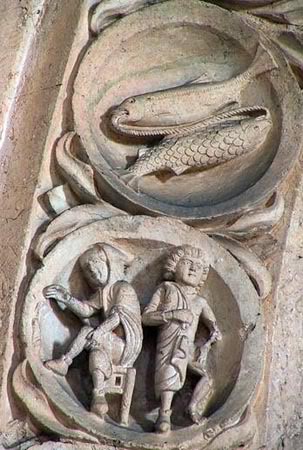
 |
Freethought & Rationalism ArchiveThe archives are read only. |
|
|
#11 | ||
|
Contributor
Join Date: Mar 2003
Location: London UK
Posts: 16,024
|
Quote:
Quote:
|
||
|
|
|
|
#12 | ||
|
Contributor
Join Date: Mar 2003
Location: London UK
Posts: 16,024
|
Quote:
Let us ignore the fact this is by the Theosophical society - this is accepted history. http://iidb.infidels.org/vbb/showthread.php?t=243744 Quote:
|
||
|
|
|
|
#13 | |
|
Contributor
Join Date: Mar 2003
Location: London UK
Posts: 16,024
|
Quote:
Did anyone here write that? |
|
|
|
|
|
#14 |
|
Regular Member
Join Date: Apr 2008
Location: Copenhagen, Denmark
Posts: 322
|
Nice articles. I've also pondered on Enki/Ea quite abit and he's a very interesting god. I believe Ea was immensely popular and had a huge period as chief diety throughout large areas of Mesopotamia before Marduk's rise, as also said in the theosophical piece. And is arguably identified with Jah (Ea = Ia) at Ebla. It was also Ea who warned the Babylonian Noah of the impending flood since he had such a love for mankind. And I've speculated freely that he was also the influence of the Jahve which helped Moses with magic tricks against pharaoh aswell as other early aspects of Jahve.
The first incarnation of Vishnu was also as a half-man half-fish, I believe. And that it was in this fish-form Vishnu saved the Hindu Noah's ark, dragging it unto a top of a rock. Vishnu's consort Davkina is prolly the same as Ea's consort Dav-ki. The Babylonians are said to have considered divine Wisdom to reside in water, especially the abzu, and Ea exercised power over the divine creational principle by controlling the masculine and feminine forces with his mere thoughts. And the ancient Babylonian powerful fertility symbol of the creational (holy) waters of the womb united with the phallos, as seen here by Oannes/Dagon, is continued in various religions today, incl. Catholicism it seems. Effectively making the priests Ioannes/Dagon/John the Baptists? I've also heard the Pope's mitre is relic of the Oannes/Dagon priests lol! Seems mostly like anti-Catholic propaganda to me, but who knows.    The Greeks could've perhaps added the "I" infront of Oannes thus forming the Greek title Io? As in Ionah or "Iota", the yod (=10), a mystic symbol for Jahve (10 in our numbers are the phallos and oval) aswell as for Jesus (first letter). And perhaps as in the Latin Jupiter, Juno and Jove. If Ea was the origin of the sign of Aquarius the waterman, as has been suggested, we might also draw parallels with John the Baptist here in an astal-theological understanding. The fish symbolism of Jesus could also have come from either equating Jesus the Christ with Jesus the son of Fish, Moses's powerful successor who lead the Israelites to the promised land (Joshua ben Nun). This equation would not be unlike the essenes with thier suffering Teacher of Righteousness, seeing everything in divine cycles of history as they did. Jesus/Joshua of the Fish come back to lead the Jews to salvation once again. Or as I've said, JC as the minister of the "age of Pisces". I read recently that the two fishes is often pictured in the Roman catacombs, the fish being the early secret Christian symbol. Its not uncommon to see the astrological symbol of Pisces in churches. Why, I dont know. But its certainly befitting.  
|
|
|
|
|
#15 |
|
Regular Member
Join Date: Apr 2008
Location: Copenhagen, Denmark
Posts: 322
|
I've also been led to believe that the concept of John the Baptist is also arguably a play on words from the Semitic origin of that character lost in the Greek interpretation: that the Aramaic word "baptise" is 'amad and the Hebrew word "pillar" is the same word, 'amad (also means "stand" which perhaps accounts for Simon Magus's title 'the Standing One', a mistranslation of 'the Pillar').
Thus John the Baptist is also John the Pillar. Not insignificant considering the importance of the symbolism of "Pillar" in the early Christian context. It may seem strange or coincidental, but if we follow that line of thought we could begin see John the Baptist as the "Pillar of Dawn", which was a Hebrew name for the Day-star or Morningstar, Venus. Which not only precedes the light and brings the light into the world (the sun) though it is not itself the light, but also "baptises" the earth with the morning dew (Pliny) in a fertility understanding as with the baptism ritual. Which is all precisely the description and the role of John. Note also the name of the mystical Judaeo-Christian sect of the Haemerobaptists, meaning Day-bathers - or Day-Pillars/Pillars of Dawn. Now, if John is the baptizer/Pillar of Water (cloud) then his successor would naturally be the baptizer/Pillar of Fire? The two pillars of Jahve (male/female). Venus as the Morninstar is evidently a mystic symbol in Christianity and all these "pillars" of the early church would surely be considered as having the "Day-star risen in their hearts" as Peter says in some mystical understanding (2 Peter 1:19). Jesus himself is the Morningstar (Rev 22:16) and in Rev 2:26-28 it is apparently equated with divine power. |
|
|
|
|
#16 | |
|
Banned
Join Date: Apr 2004
Location: Alberta
Posts: 11,885
|
Quote:
Oh, for sure no historical Jesus or he could not come again . . . wherefore pillar John had to stay as if he was the Alpha determinate while Jesus is the Omega through the ages bringing new earthly riches home. Remember here that John was born out of the tradition and Jesus was from this generation. . . bosum buddies for sure but greater was John by far. |
|
|
|
| Thread Tools | Search this Thread |
|